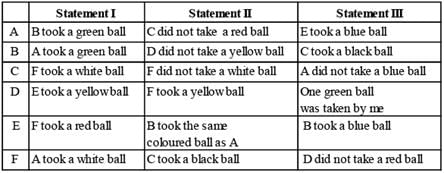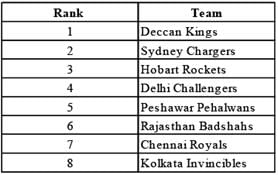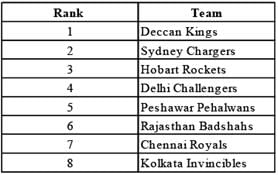Test: Analytical Reasoning - 4 - CAT MCQ
10 Questions MCQ Test - Test: Analytical Reasoning - 4
Directions: Answer the questions on the basis of the information given below.
Each of the six persons namely A, B, C, D, E and F took one ball from a box containing 300 balls of six different colours Blue, Black, Red, White, Green and Yellow. Also, the number of balls of each colour is the same. Following is the detail of three statements made by each of the persons. Exactly one of the statements made by each person is true and only one of the statements made about B is correct. Also, balls of two particular colours were not taken by any of the persons.
(2012)

Q. What is the colour of the ball taken by A?
Each of the six persons namely A, B, C, D, E and F took one ball from a box containing 300 balls of six different colours Blue, Black, Red, White, Green and Yellow. Also, the number of balls of each colour is the same. Following is the detail of three statements made by each of the persons. Exactly one of the statements made by each person is true and only one of the statements made about B is correct. Also, balls of two particular colours were not taken by any of the persons.

Directions: Answer the questions on the basis of the information given below.
Each of the six persons namely A, B, C, D, E and F took one ball from a box containing 300 balls of six different colours Blue, Black, Red, White, Green and Yellow. Also, the number of balls of each colour is the same. Following is the detail of three statements made by each of the persons. Exactly one of the statements made by each person is true and only one of the statements made about B is correct. Also, balls of two particular colours were not taken by any of the persons.
(2012)

Q. What is the colour of the ball taken by C?
Each of the six persons namely A, B, C, D, E and F took one ball from a box containing 300 balls of six different colours Blue, Black, Red, White, Green and Yellow. Also, the number of balls of each colour is the same. Following is the detail of three statements made by each of the persons. Exactly one of the statements made by each person is true and only one of the statements made about B is correct. Also, balls of two particular colours were not taken by any of the persons.

Directions: Answer the questions on the basis of the information given below.
Each of the six persons namely A, B, C, D, E and F took one ball from a box containing 300 balls of six different colours Blue, Black, Red, White, Green and Yellow. Also, the number of balls of each colour is the same. Following is the detail of three statements made by each of the persons. Exactly one of the statements made by each person is true and only one of the statements made about B is correct. Also, balls of two particular colours were not taken by any of the persons.
(2012)

Q. For how many of the mentioned persons, the exact colour of the balls taken by them can be determined?
Each of the six persons namely A, B, C, D, E and F took one ball from a box containing 300 balls of six different colours Blue, Black, Red, White, Green and Yellow. Also, the number of balls of each colour is the same. Following is the detail of three statements made by each of the persons. Exactly one of the statements made by each person is true and only one of the statements made about B is correct. Also, balls of two particular colours were not taken by any of the persons.

Directions: Answer the questions on the basis of the information given below.
Eight teams participate in the Indian Soccer League (ISL) in which they play one another exactly once. The winner gets three points while the loser gets no points from a match. Both the teams get one point each if the match results in a draw. It is known that not more than 3 matches resulted in a draw in the tournament. The teams are ranked in the following manner before the tournament starts:

The new ranks of the eight teams would be decided based on their performance in the ISL, with the team scoring the maximum points ranked 1 and so on. If two or more teams score equal points at the end of the tournament, their final ranks would be decided based on the total number of goals scored in the tournament, with more goals giving a team better rank.
An “upset” is said to have happened when a lower ranked team defeats a higher ranked team in a match.
(2012)
Q. If Rajasthan Badshahs came in the top four teams after ISL, then what is the minimum number of upsets that must have happened?
Directions: Answer the questions on the basis of the information given below.
Eight teams participate in the Indian Soccer League (ISL) in which they play one another exactly once. The winner gets three points while the loser gets no points from a match. Both the teams get one point each if the match results in a draw. It is known that not more than 3 matches resulted in a draw in the tournament. The teams are ranked in the following manner before the tournament starts:

The new ranks of the eight teams would be decided based on their performance in the ISL, with the team scoring the maximum points ranked 1 and so on. If two or more teams score equal points at the end of the tournament, their final ranks would be decided based on the total number of goals scored in the tournament, with more goals giving a team better rank.
An “upset” is said to have happened when a lower ranked team defeats a higher ranked team in a match.
(2012)
Q. If Hobart Rockets retained Rank 3, then what is the maximum number of upsets that could have happened?
Directions: Answer the questions on the basis of the information given below.
Eight teams participate in the Indian Soccer League (ISL) in which they play one another exactly once. The winner gets three points while the loser gets no points from a match. Both the teams get one point each if the match results in a draw. It is known that not more than 3 matches resulted in a draw in the tournament. The teams are ranked in the following manner before the tournament starts:

The new ranks of the eight teams would be decided based on their performance in the ISL, with the team scoring the maximum points ranked 1 and so on. If two or more teams score equal points at the end of the tournament, their final ranks would be decided based on the total number of goals scored in the tournament, with more goals giving a team better rank.
An “upset” is said to have happened when a lower ranked team defeats a higher ranked team in a match.
(2012)
Q. If 27 matches in ISL resulted in upsets, then what is the maximum number of teams who could have retained their initial ranks?
Directions: These questions are based on the following information
IT School of Management is a management institute involved in teaching,training and research. Currently it has 37 faculty members. They are involved in three jobs: teaching, training and research. Each faculty member working with IT School of Management has to be involved in at least one of the three jobs mentioned above:
- A maximum number of faculty members are involved in training. Among them, a number of faculty members are having additional involvement in the research.
- The number of faculty members in research alone is double the number of faculty members involved in all the three jobs.
- 17 faculty members are involved in teaching. The number of faculty members involved in teaching alone is less than the number of faculty members involved in research alone.
- The faculty members involved in the teaching are also involved in at least one more job.
(2011)
Q. After sometime,the faculty members who were involved in all the three tasks were asked to withdraw from one task. As a result, one of the faculty members each opted out of teaching and research, while remaining ones involved in all the three tasks opted out of training. Which one of the following statements, then necessarily follows:
Directions: These questions are based on the following information
IT School of Management is a management institute involved in teaching,training and research. Currently it has 37 faculty members. They are involved in three jobs: teaching, training and research. Each faculty member working with IT School of Management has to be involved in at least one of the three jobs mentioned above:
- A maximum number of faculty members are involved in training. Among them, a number of faculty members are having additional involvement in the research.
- The number of faculty members in research alone is double the number of faculty members involved in all the three jobs.
- 17 faculty members are involved in teaching. The number of faculty members involved in teaching alone is less than the number of faculty members involved in research alone.
- The faculty members involved in the teaching are also involved in at least one more job.
(2011)
Q. Based on the information given above, the minimum number of faculty members involved in both training and teaching, but not in research is:
Directions: These questions are based on the following information
IT School of Management is a management institute involved in teaching,training and research. Currently it has 37 faculty members. They are involved in three jobs: teaching, training and research. Each faculty member working with IT School of Management has to be involved in at least one of the three jobs mentioned above:
- A maximum number of faculty members are involved in training. Among them, a number of faculty members are having additional involvement in the research.
- The number of faculty members in research alone is double the number of faculty members involved in all the three jobs.
- 17 faculty members are involved in teaching. The number of faculty members involved in teaching alone is less than the number of faculty members involved in research alone.
- The faculty members involved in the teaching are also involved in at least one more job.
(2011)
Q. Among Anil, Bibek, Charu, Debu and Eswar, Eswar is taller than Debu but not as fat as Debu. Charu is taller than Anil but shorter than Bibek. Anil is fatter than Debu but not as fat as Bibek. Eswar is thinner than Charu, who is thinner than Debu. Eswar is shorter than Anil. Who is the thinnest person?
Directions: Read the following information and answer the quetions that follow:
The cars at a dealership come with a choice of the following options : air-conditioning, a cassette deck, leather seats, power windows, a sunroof and tinted glass. None of the cars has any other optional equipment. The following conditions apply : If a car has leather seats, it also has a cassette deck. If a car has a cassette deck, it also has power windows; If a car has power windows, it also has a cassette deck.
Cars with tinted glass have a sunroof, but no air-conditioning. Cars that have air-conditioning have, at most, two other options.
(2010)
Q. If a car has both tinted glass and leather seats, what is the greatest number of additional options that the car could have?



















